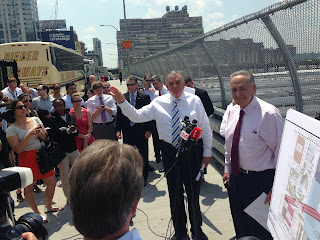Since the NJ Transit tunnel under the Hudson River was killed over two years ago, planners have been crossing their fingers for a second “Gateway" tunnel - this one for Amtrak trains. Now, that hope is getting some serious backing, in the form of a $185 million cash infusion from post-Sandy aid. The funds will be used to build an 800-foot concrete encasement between 10th and 11th Avenues to preserve the tunnel right-of-way, while Manhattan's massive Hudson Yards development project rises. A complete under-river crossing is still years away. The funding comes from the Sandy relief package, because the storm showed the vulnerability of present Hudson River crossings.
New York will get $185 million in federal aid to begin constructing a new rail tunnel under the Hudson River, a project that has long eluded elected officials and transportation advocates seeking to expand rail capacity along the congested Northeast corridor.
Funding for the full project, known as Gateway, is still years away. But, the U.S. Department of Transportation approved preliminary funding as part of the Superstorm Sandy relief package approved by Congress earlier this year.
Sen. Charles Schumer, standing with U.S. Transportation Secretary Ray LaHood on the 11th Avenue overpass overlooking the Hudson Yards, said the funding was important because it will preserve the right-of-way for the full Gateway project to be built, when and if the billions of dollars needed to fund it are secured. The Sandy relief bill provided an expedient way to get the money before the private developers of the rail yards built over where the tunnel must go.
“They weren’t going to wait two years; they were going to build,” Mr. Schumer said, referring to The Related Cos., the main developers of the Hudson Yards project. “Sandy relief funding was available, the criteria fit, and the money was getting through quickly and fit the timetable.”
The funds will go toward building an 800-foot-long concrete casement—known as a “tunnel box”—between 10th and 11th avenues. Mr. Schumer said the hope is to eventually build two flood-resistant tunnels under the river to Manhattan’s Penn Station.
“I don’t know if the Related Cos. could have waited any longer,” he said. “They’ve got loans. Every year they wait to build … is money out of their pocket. We asked them to delay months. But if we’d asked them to delay years, they may have said no.”
Questioned about the chances of funding for the entire Gateway project, Mr. Schumer said there already was money in this year’s budget to begin the planning and design. “There are a lot of ifs,” he conceded. “Can we get $13 billion in two years? What if we get $3 billion?”
Mr. La Hood interjected, “There’s no number right now. This is like building the interstate system. You build part of it, you get the money, and then you build the next part. The answer is there’s no number right now.”
Indeed, that is the typical experience for massive transportation projects, according to industry experts.
But sometimes hundreds of millions of dollars are spent on projects that are never completed or even canceled, as happened with the Access to the Region’s Core tunnel called off by New Jersey Governor Chris Christie.
Mr. Schumer vowed to scour the federal government for all available dollars, including bonds and loan programs, to help pay for the Gateway project.
The Access to the Region’s Core—or ARC—tunnel, also to be built under the Hudson, was scrapped in 2010 by Mr. Christie, who feared that cost overruns would be borne by his state. The Gateway project came along a year later.
The initial 800-foot concrete encasement is being constructed by general contractor Tutor Perini Building Corp. Estimated costs for the entire Gateway Hudson River Tunnel project range from of $14.5 billion to $18 billion, with an proposed completion date of 2025.



